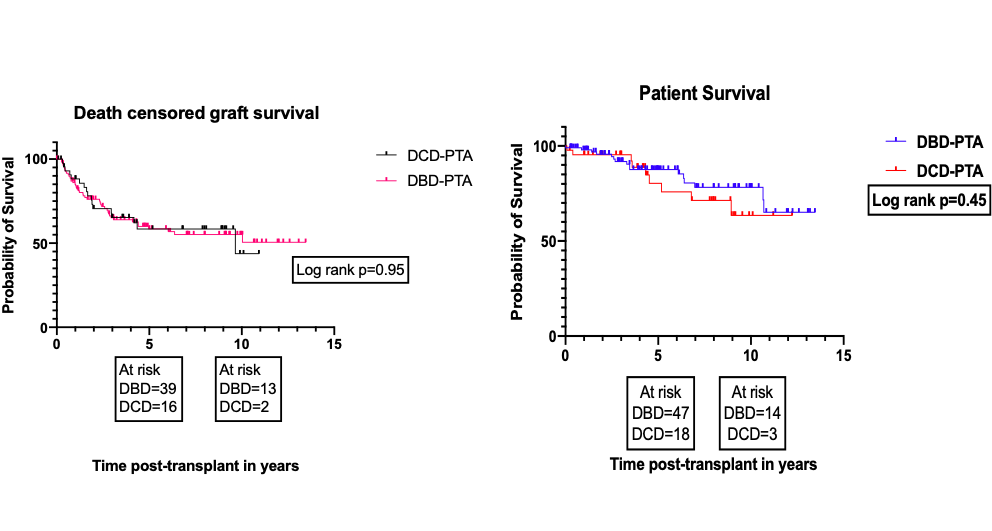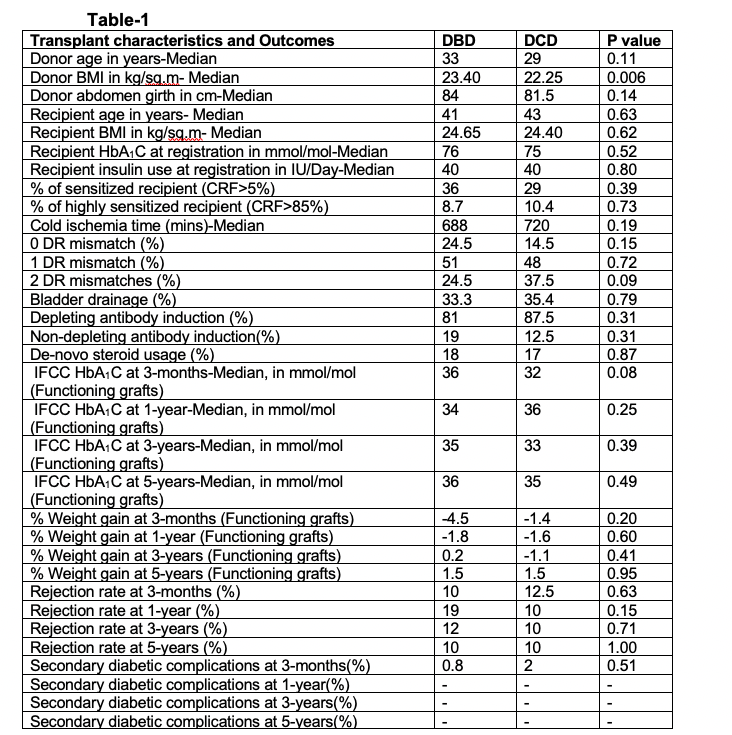Metabolic Outcomes After Pancreas Transplant Alone from Donation After Circulatory Death Donor – The UK Registry Analysis
Imperial College Renal and Transplant Center, Hammersmith Hospital, Imperial College Healthcare NHS Trust, London, United Kingdom
Meeting: 2022 American Transplant Congress
Abstract number: 1154
Keywords: Circulatory Death, Donors, non-heart-beating, Outcome, Pancreas transplantation
Topic: Clinical Science » Pancreas » 65 - Pancreas and Islet: All Topics
Session Information
Session Name: Pancreas and Islet: All Topics
Session Type: Poster Abstract
Date: Sunday, June 5, 2022
Session Time: 7:00pm-8:00pm
 Presentation Time: 7:00pm-8:00pm
Presentation Time: 7:00pm-8:00pm
Location: Hynes Halls C & D
*Purpose: Extrapolating data from early DCD (donation after circulatory death) kidney transplantation, pancreas transplants from DCD grafts were feared to have worse metabolic outcomes. Hence, we aimed to address the question of solitary pancreas transplant from DCD donors- are our concerns justified?
*Methods: A UK registry analysis of 185 PTA (pancreas transplant alone) performed from 2005 to 2018 was conducted. All early graft losses (<3 months) were excluded in this analysis to allow focus on the metabolic outcomes. The primary aim was to compare the metabolic outcomes between DBD (donation after brainstem death) & DCD grafts (HbA1C, weight gain & incidence of secondary diabetic complications); secondary aim was to compare rejection rates (including the need for steroids), patient & graft survival between the two groups. Functioning graft is defined as remaining insulin independent. Secondary diabetic complications are defined as any of the following events: myocardial infarction, cerebrovascular accident, limb amputations
*Results: After excluding early graft losses (n=23, DBD=16 & DCD=7); data from 162 PTA (DBD=114 & DCD=48) were analyzed to compare the metabolic outcomes. The average functional warm ischemia time (time from systolic BP<50mmHg to commencement of perfusion) for DCD group was 17+5.1 mins. Transplant characteristics & outcomes as shown in table-1. BMI of the donor was less in DCD cohort (DBD=23.40 vs. DCD=22.25, P=0.006). Both the DBD & DCD recipients had similar rates of depleting antibody induction & de novo steroid usage (Table-1). The steroid-free maintenance rates were equivalent in both the groups (DBD=75% vs. DCD=73%, p=0.79). There were no significant differences in the HbA1C, weight gain, rejection rate, & incidence of secondary diabetic complications post-transplant between DBD & DCD recipients (Table-1). The 1-, 5-, &10-years patient and graft survival were similar in both the groups (Figure-1).
*Conclusions: This is the first & the biggest study worldwide reporting equivalent metabolic outcomes and survival (patient/graft) after PTA from DCD grafts to that of DBD grafts with more than 10-years follow up.
To cite this abstract in AMA style:
Gopal J, McLean A, Muthusamy A. Metabolic Outcomes After Pancreas Transplant Alone from Donation After Circulatory Death Donor – The UK Registry Analysis [abstract]. Am J Transplant. 2022; 22 (suppl 3). https://atcmeetingabstracts.com/abstract/metabolic-outcomes-after-pancreas-transplant-alone-from-donation-after-circulatory-death-donor-the-uk-registry-analysis/. Accessed November 25, 2025.« Back to 2022 American Transplant Congress


